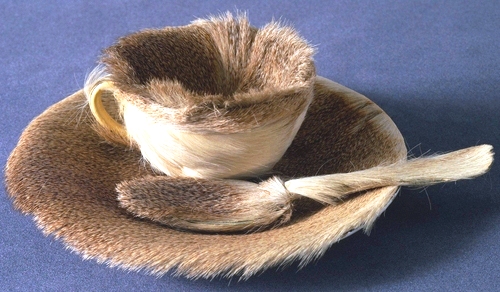by Mariano Akerman

Medieval sculpture. Last Judgement Tympanum: The Damned, Bamberg cathedral, 13th century

Gothic sculpture. Master Heinrich of Constance, The Visitation, c. 1310-20. Polychrome walnut, with gilding and rock crystal cabechons. German sculpture, from Katharienenthal Abbey, Switzerland. Metropolitan Museum of Art, New York

Stephen Lochner, The Madonna in the Rose Bower (Maria am Rosenhag), 1448. Wallraf-Richartz Museum, Cologne

Medieval print. Hartmann Schedel, The Monstrous Races: "Blemmyae," from Liber chronicarum (Die Schedelsche Weltchronik, Das Buch der Croniken und Geschichten von Hartmann Schedel), woodcut, 1493

Renaissance painting. Albrecht Dürer, Self-Portrait, 1498

Renaissance print. Moses leads the Children of Israel through the Red Sea, from The Luther Bible, Germany, c. 1530

Christoph Jamnitzer, Neuw Grotteßken Buch (New Book of Grotesques), Nuremberg 1610

Friedrich Unteutsch, Gristly Motif (Knorpelwerk), engraving, 1650

Johann Heinrich Keller, Cartilaginous Grotesque (Knorpelgroteske), engraving, 1680

Rococo engraving. Johann Georg Hertel (after Jeremias Wachsmuth), Winter, Rococo Music, Fancy Dress Ball, etching, 1750-60

Romanticism. Runge, Self-Portrait, oil, 1810

Caspar David Friedrich, The Wreck of Hope, oil, 1823-4. Hamburger Kunsthalle

Realism. Karl Edouard Biermann, Borsig Engineering Work in Berlin (Borsig's Maschinenbau-Anstalt zu Berlin), oil, 1847. Stadtmuseum Berlin

Impressionism. Max Liebermann, Country Tavern at Brannenburg, oil, 1893. Musée d'Orsay, Paris

Jugendstil (Art Nouveau). Ephraim Lilien, "The Covenant of Abraham," Die Bücher der Bible, 1908

Expressionism 1. Die Brücke (The Bridge). Karl Schmidt-Rottluff, Girl from Kowno (Madchen aus Kowno), woodcut, 1918. Brücke Museum, Berlin

Expressionism 2. Der Blaue Reiter (The Blue Rider). Franz Mark, The White Bull (detail from Cattle), oil, 1913

Neue Sachlichkeit (New Objectivity). George Grosz, Café Megalomania, pen and ink, 1915. Galerie St. Etienne, New York

Dada. John Heartfield, Dada Photomontage, 1917

Social Realism. Käthe Kollwitz, The Mothers, woodcut, 1921

Surreal sculpture. Meret Oppenheim, Object (Breakfast in Fur), 1936. Museum of Modern Art, New York

Surreal collage. Max Ernst, She looked slightly like a horse, 1937

Bauhaus. Mies van der Rohe, Model for a Glass Skycreaper (Maquette Glazen Wolkenkrabber), 1922

Totalitarian propaganda. Modern art presented as DEGENERATE "ART" (Entartete "Kunst"). Catalog of Munich 1937 exhibition features on its cover a sculpture by German expressionist artist Otto Freundlich, The New Man (Der neue Mensch), 1912

Karl Schwesig, "Anyone could participate in the beatings," from the Drumstick Cellar (Schlegelkeller−Zyklus), 1935-37. A pen and ink drawing from his (now mostly lost) 48-images series. Düsseldorf Stadtmuseum

John Heartfield, And Yet It Moves, photomontage, 1943

Andreas Paul Weber, March into the Grave, lithograph, 1932

Informalism. Abstract painting by Hans Hartung

Ernst Kahl, The Fighting Dog (Der Kampfhund), on the cover of In the refrigerator light still burns (Im Kühlschrank brennt noch Licht), record, 1996

Anselm Kiefer, Margarete (Dein goldenes Haar, Margarethe), mixed media, 1981
Above-featured artworks were explored by Mariano Akerman along the series of educational lectures and workshops Shape and Meaning, Islamabad and Rawalpindi, November-December 2010

1. Looking at Pictures and Learning from Art
Islamabad College for Girls, 23 November 2010
2. The Grotesque in German Art. Its Nature, Transformations and Importance in Aesthetics
Islamabad College for Girls, 8 December 2010
3. Modern Art
Post-Graduate College for Women, Rawalpindi, 9 December 2010
4. The Bible and the Visual Arts
Khatoon-e-Fatima School, Islamabad, 10 December 2010
5. Bible-inspired Symbolism in German Art
Khatoon-e-Fatima School, Islamabad, 14 December 2010

1. Looking at Pictures and Learning from Art
Islamabad College for Girls, 23 November 2010
2. The Grotesque in German Art. Its Nature, Transformations and Importance in Aesthetics
Islamabad College for Girls, 8 December 2010
3. Modern Art
Post-Graduate College for Women, Rawalpindi, 9 December 2010
4. The Bible and the Visual Arts
Khatoon-e-Fatima School, Islamabad, 10 December 2010
5. Bible-inspired Symbolism in German Art
Khatoon-e-Fatima School, Islamabad, 14 December 2010
Shape and Meaning: The German Contribution to the Visual Arts - Five Educational Lectures by Mariano Akerman, German Embassy Islamabad, 3.1.2011, Education & Culture
More on famous German artists:
Albrecht Dürer
Anton Raphael Mengs
Caspar David Friedrich
Max Liebermann
Franz Marc
Max Ernst
Paul Klee
Kathe Kollwitz
Hans Hartung
Anselm Kiefer


























